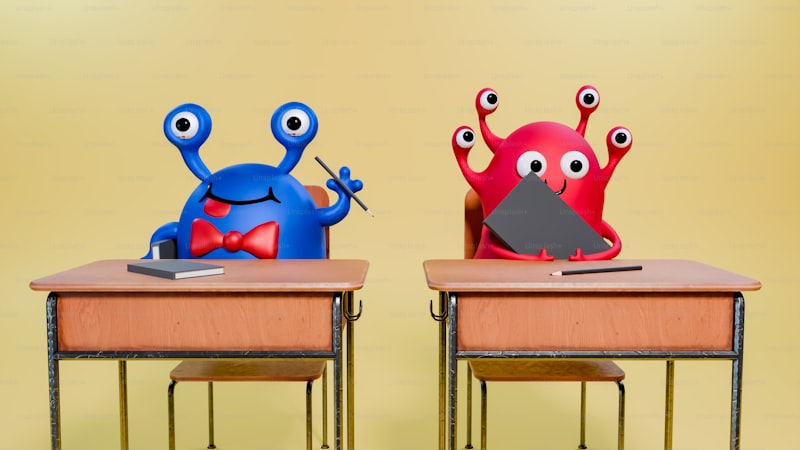Take the sea slug Aplysia, for example. Its nervous system is relatively simple, yet it displays associative learning. When repeatedly exposed to a benign stimulus paired with a mild electric shock, Aplysia learns to retract its gill and siphon in anticipation of the shock, showcasing a form of classical conditioning.
This learning process occurs due to changes in synaptic connections. The repeated stimulus causes neurotransmitters to release, strengthening connections between sensory and motor neurons. This synaptic plasticity underpins the slug’s learned response, demonstrating how even basic nervous systems can encode memories.
In honeybees, another fascinating case emerges. These insects show complex learning behaviors critical for foraging efficiency and hive survival. They learn to associate floral scents with food rewards and can communicate these findings to other bees through dance language.
This learning ability correlates with specific neural structures in the bee brain, such as the mushroom bodies, where sensory information is processed and integrated. Neural plasticity within these structures allows bees to form and retain memories essential for navigating their environment.
Tiny Brains, Big Discoveries: Unraveling the Neurobiology of Learning in Invertebrates
Did you know that some of the smallest creatures on Earth are revealing big secrets about how brains work? Invertebrates, despite their lack of a backbone, possess fascinating abilities to learn and adapt to their environments. From octopuses to bees, these tiny beings showcase a remarkable capacity for learning that challenges traditional views of intelligence.
Invertebrates like octopuses have garnered attention for their intricate problem-solving skills. These creatures, with their decentralized nervous systems, demonstrate complex behaviors such as tool use and camouflage adaptation. Their ability to learn from experiences and apply this knowledge to novel situations suggests a sophisticated form of intelligence.
Bees, on the other hand, exhibit astonishing cognitive abilities through their navigation and communication skills. The famous waggle dance, used to convey information about food sources, illustrates a precise form of communication that aids their survival. Bees can learn to recognize specific floral patterns and remember their locations, optimizing their foraging efficiency.
Understanding the neurobiology of learning in invertebrates involves exploring their neural structures and how these support cognitive functions. Despite having smaller brains, these creatures utilize specialized neural circuits to process information and form memories. This adaptation allows them to learn from past experiences and adjust their behaviors accordingly.
The study of invertebrate neurobiology challenges the notion that complex learning requires a large brain. Instead, it highlights the diversity of neural strategies across different species. By unraveling these mechanisms, scientists not only gain insights into the evolution of intelligence but also explore potential applications in artificial intelligence and robotics.

In summary, invertebrates with their tiny brains continue to amaze scientists with their ability to learn, adapt, and thrive in diverse environments. The ongoing research into their neurobiology promises to uncover more about the fundamental principles of learning and cognition, offering valuable lessons that extend beyond the animal kingdom.
From Sea Slugs to Honeybees: How Invertebrates Teach Us About Learning Mechanisms
Have you ever wondered how creatures as seemingly simple as sea slugs and honeybees can teach us profound lessons about learning? Despite lacking a complex brain like mammals, these invertebrates showcase astonishing learning abilities that challenge our understanding of intelligence.
Let’s start with sea slugs, particularly the Aplysia species. These marine mollusks have been pivotal in neuroscience for decades. What makes them fascinating is their simple nervous system, yet they exhibit forms of associative learning. Researchers have studied Aplysia to understand basic mechanisms like habituation and sensitization. Imagine a sea slug learning to react less to repeated stimuli or becoming more responsive to potentially harmful ones. These behaviors not only help them survive but also provide insights into how our own brains process information.
Moving on to honeybees, they demonstrate remarkable cognitive abilities within their colonies. These tiny insects navigate complex environments, communicate through intricate dances, and learn to identify floral patterns for efficient foraging. Their ability to learn from other bees’ waggle dances to locate food sources illustrates a sophisticated form of social learning. Such behaviors not only ensure the colony’s survival but also shed light on decentralized decision-making processes in biological systems.
What’s intriguing is how these invertebrates achieve such feats without a centralized brain. Instead, they rely on distributed neural networks and specialized behaviors honed through evolution. This decentralized approach challenges our traditional views of intelligence, suggesting that complex behaviors can emerge from relatively simple neural architectures.
In essence, studying sea slugs and honeybees isn’t just about marveling at their abilities; it’s about unlocking the secrets of learning itself. By understanding how these creatures learn and adapt, scientists gain insights into the fundamental principles of neural processing and adaptive behavior. It’s akin to unraveling a puzzle where each new discovery adds a piece, revealing a broader picture of how learning mechanisms have evolved across different species.
The Surprising Intelligence of Invertebrates: Insights into Learning and Memory
Take the octopus, a marvel of underwater agility. Despite lacking a vertebrate brain, it navigates mazes, camouflages seamlessly, and even opens jars—a testament to its problem-solving prowess. Such feats highlight not just instinct but a capacity for learning from experiences, adapting strategies, and recalling successful outcomes.
Insects, too, exhibit remarkable cognitive feats. Bees, for instance, not only remember the location of food sources but also communicate this information through dance, indicating a sophisticated form of memory. Their ability to navigate varying landscapes while maintaining precise navigation to their hive showcases a blend of memory, spatial awareness, and environmental adaptation.
Ants, renowned for their social organization, utilize pheromones to communicate and coordinate complex tasks. Their colonies operate with a collective memory that informs decisions about foraging patterns, nest construction, and defense strategies. This communal memory enables them to respond effectively to environmental changes and threats.
Even simpler invertebrates, like the honeybee, display associative learning—a fundamental form of memory that links specific stimuli with outcomes. Through repeated exposure, these creatures learn to associate floral scents with nectar rewards, optimizing foraging efficiency.
Neuroplasticity Without a Backbone: Exploring Learning Pathways in Invertebrate Species
Did you know that intelligence and learning aren’t limited to creatures with a backbone? Invertebrate species, despite lacking a spine, exhibit fascinating abilities when it comes to neuroplasticity and learning. From octopuses to insects, these animals showcase remarkable adaptive behaviors that challenge conventional views of intelligence.
Take the octopus, for example. These cephalopods possess a highly developed nervous system with intricate neural structures that enable complex problem-solving and learning from experience. They can manipulate objects, solve puzzles, and even exhibit curiosity—a trait often associated with higher cognitive functions.
Insects, on the other hand, demonstrate learning abilities through sensory inputs and behavioral responses. Creatures like bees and ants can learn to associate specific cues with rewards or dangers, altering their behavior accordingly. This capability helps them navigate complex environments and optimize their foraging strategies.
The secret lies in their neural circuits, which, despite being different from vertebrates, show remarkable flexibility. Neuroplasticity in invertebrates involves the ability of neurons to form new connections or strengthen existing ones in response to stimuli or experiences. This adaptation allows them to learn from past encounters, adjust behaviors, and survive in diverse ecological niches.
Understanding neuroplasticity in invertebrates not only sheds light on their cognitive abilities but also challenges our understanding of intelligence itself. These creatures navigate their worlds through a combination of innate behaviors and learned responses, showcasing a spectrum of learning pathways that contribute to their survival and success.
In summary, while vertebrates like humans and mammals often take the spotlight in discussions of intelligence and learning, invertebrate species offer a unique perspective. Their neural adaptations and learning capabilities, driven by neuroplasticity, underscore the diversity of cognitive processes in the animal kingdom.
Memory on the Move: How Invertebrates Adapt and Learn in Changing Environments
Imagine a hermit crab, its soft body protected within a borrowed shell. As it scuttles along the sandy shore, seeking a new home, it remembers past encounters with predators and safe havens. This memory isn’t just about survival—it’s a dynamic tool that allows the crab to navigate complex environments with agility and caution.
Invertebrates utilize memory to find food sources efficiently. Take the humble honeybee, buzzing from flower to flower in search of nectar. Through associative learning, it remembers the location of productive blooms and communicates these findings to its hive mates. This collective memory ensures the colony’s success in gathering resources, vital for sustaining the entire ecosystem.
Adaptation in invertebrates isn’t just instinctual; it’s a product of their learning experiences. Consider the octopus, a master of disguise in the ocean depths. This intelligent creature learns from interactions with its surroundings, changing color and texture to blend seamlessly with coral reefs or rocky seabeds. Each adaptation is a testament to its memory of successful camouflage strategies.

In a world where environments can change rapidly due to climate shifts or human impact, invertebrates’ adaptive memory becomes even more critical. Species like the Antarctic krill, small crustaceans crucial to marine food webs, adjust their behavior based on shifting ice patterns and predator movements. Their ability to remember and respond to these changes ensures their survival amidst uncertainty.
The study of invertebrate memory underscores the intricate relationship between cognition and environment. It challenges our understanding of intelligence and adaptation, showing that even creatures without a centralized brain can exhibit complex behaviors shaped by experience and memory. As researchers delve deeper into the mechanisms behind these adaptations, they uncover new insights into the resilience and versatility of life forms across the planet.
Uncovering the Neural Circuits: A Deep Dive into Learning Processes in Invertebrates
Have you ever wondered how tiny invertebrates like insects and mollusks learn and adapt to their environments? It turns out that these creatures, despite lacking a complex brain like mammals, possess fascinating neural circuits that facilitate learning and memory. Invertebrates utilize specialized neural pathways to process information, navigate their surroundings, and even learn from past experiences.
The study of neural circuits in invertebrates offers valuable insights into fundamental learning processes. For example, in creatures like the sea slug Aplysia, researchers have identified specific neurons responsible for associative learning. These neurons form connections that strengthen with repeated stimuli, allowing the slug to associate certain behaviors with rewards or punishments. This process mirrors classical conditioning observed in higher animals.
Furthermore, insects like fruit flies showcase remarkable sensory-motor integration through their neural networks. Their ability to learn to associate specific odors with food sources or dangers demonstrates complex neural computations at work. These insects adapt their behaviors based on past experiences, a crucial survival strategy in their ever-changing environments.
Studying neural circuits in invertebrates isn’t just about understanding their biology; it also sheds light on broader evolutionary principles. By comparing the neural mechanisms across different species, scientists uncover common principles of learning and memory formation that transcend evolutionary boundaries.
The exploration of neural circuits in invertebrates unveils the intricacies of learning processes in these seemingly simple creatures. From sea slugs to insects, each species offers a unique perspective on how neural circuits facilitate adaptive behaviors and survival strategies. This research not only enriches our understanding of animal cognition but also inspires innovations in artificial intelligence and robotics, drawing parallels between biological and technological learning systems.
Frequently Asked Questions
How do invertebrates learn without brains
Learn how invertebrates, despite lacking brains, demonstrate learning abilities through decentralized nervous systems and sensory responses. Explore how simple organisms adapt behaviorally to environmental cues, revealing surprising complexities in non-neural learning mechanisms.
What is neurobiology of learning in invertebrates
Discover how invertebrates, despite lacking a vertebrate brain, exhibit intricate learning behaviors through neurobiological processes. Explore the mechanisms behind memory formation, synaptic plasticity, and sensory integration in these organisms, shedding light on their adaptive capabilities.
Which invertebrates show notable learning abilities
Discover which invertebrates demonstrate remarkable learning abilities. Learn about specific examples and understand how these creatures adapt and problem-solve in their environments through learning.
Why study neurobiology of learning in invertebrates
Discover why studying the neurobiology of learning in invertebrates is valuable, uncovering fundamental insights into learning mechanisms across species, providing comparative models for understanding human cognition, and offering potential applications in fields such as neuroscience and artificial intelligence.
What are the key neural mechanisms behind invertebrate learning
Discover the fundamental neural processes that drive learning in invertebrates, exploring key mechanisms that underpin their adaptive behaviors and cognitive functions.


